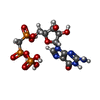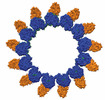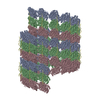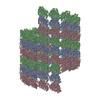[English] 日本語
 Yorodumi
Yorodumi- EMDB-8997: 13-pf 3-start GMPCPP-human alpha1B/beta3 microtubules decorated w... -
+ Open data
Open data
- Basic information
Basic information
| Entry | Database: EMDB / ID: EMD-8997 | |||||||||
|---|---|---|---|---|---|---|---|---|---|---|
| Title | 13-pf 3-start GMPCPP-human alpha1B/beta3 microtubules decorated with kinesin-1 motor domain | |||||||||
 Map data Map data | 13-PF 3-start GMPCPP-human alpha1B/beta3 microtubules decorated with kinesin-1 motor domain. | |||||||||
 Sample Sample |
| |||||||||
 Keywords Keywords | cytoskeleton / microtubules / recombinant human tubulin / tubulin isotype / STRUCTURAL PROTEIN | |||||||||
| Function / homology |  Function and homology information Function and homology informationnetrin receptor binding / Post-chaperonin tubulin folding pathway / dorsal root ganglion development / Cilium Assembly / cytoskeleton-dependent intracellular transport / Microtubule-dependent trafficking of connexons from Golgi to the plasma membrane / Carboxyterminal post-translational modifications of tubulin / Intraflagellar transport / Sealing of the nuclear envelope (NE) by ESCRT-III / Formation of tubulin folding intermediates by CCT/TriC ...netrin receptor binding / Post-chaperonin tubulin folding pathway / dorsal root ganglion development / Cilium Assembly / cytoskeleton-dependent intracellular transport / Microtubule-dependent trafficking of connexons from Golgi to the plasma membrane / Carboxyterminal post-translational modifications of tubulin / Intraflagellar transport / Sealing of the nuclear envelope (NE) by ESCRT-III / Formation of tubulin folding intermediates by CCT/TriC / Gap junction assembly / Prefoldin mediated transfer of substrate to CCT/TriC / Kinesins / COPI-independent Golgi-to-ER retrograde traffic / Assembly and cell surface presentation of NMDA receptors / COPI-dependent Golgi-to-ER retrograde traffic / Recycling pathway of L1 / RHOH GTPase cycle / RHO GTPases activate IQGAPs / microtubule-based process / Hedgehog 'off' state / intercellular bridge / COPI-mediated anterograde transport / Activation of AMPK downstream of NMDARs / cytoplasmic microtubule / peptide binding / MHC class II antigen presentation / Mitotic Prometaphase / EML4 and NUDC in mitotic spindle formation / Recruitment of NuMA to mitotic centrosomes / cellular response to interleukin-4 / axon guidance / HSP90 chaperone cycle for steroid hormone receptors (SHR) in the presence of ligand / Resolution of Sister Chromatid Cohesion / cell periphery / filopodium / Translocation of SLC2A4 (GLUT4) to the plasma membrane / RHO GTPases Activate Formins / PKR-mediated signaling / structural constituent of cytoskeleton / microtubule cytoskeleton organization / HCMV Early Events / Aggrephagy / The role of GTSE1 in G2/M progression after G2 checkpoint / mitotic spindle / Separation of Sister Chromatids / mitotic cell cycle / lamellipodium / double-stranded RNA binding / microtubule cytoskeleton / growth cone / Hydrolases; Acting on acid anhydrides; Acting on GTP to facilitate cellular and subcellular movement / microtubule / cilium / axon / cell division / neuronal cell body / GTPase activity / ubiquitin protein ligase binding / dendrite / GTP binding / structural molecule activity / extracellular exosome / metal ion binding / nucleus / cytoplasm Similarity search - Function | |||||||||
| Biological species |  Homo sapiens (human) Homo sapiens (human) | |||||||||
| Method | helical reconstruction / cryo EM / Resolution: 3.5 Å | |||||||||
 Authors Authors | Ti SC / Alushin GM | |||||||||
| Funding support |  United States, 2 items United States, 2 items
| |||||||||
 Citation Citation |  Journal: Dev Cell / Year: 2018 Journal: Dev Cell / Year: 2018Title: Human β-Tubulin Isotypes Can Regulate Microtubule Protofilament Number and Stability. Authors: Shih-Chieh Ti / Gregory M Alushin / Tarun M Kapoor /  Abstract: Cell biological studies have shown that protofilament number, a fundamental feature of microtubules, can correlate with the expression of different tubulin isotypes. However, it is not known if ...Cell biological studies have shown that protofilament number, a fundamental feature of microtubules, can correlate with the expression of different tubulin isotypes. However, it is not known if tubulin isotypes directly control this basic microtubule property. Here, we report high-resolution cryo-EM reconstructions (3.5-3.65 Å) of purified human α1B/β3 and α1B/β2B microtubules and find that the β-tubulin isotype can determine protofilament number. Comparisons of atomic models of 13- and 14-protofilament microtubules reveal how tubulin subunit plasticity, manifested in "accordion-like" distributed structural changes, can accommodate distinct lattice organizations. Furthermore, compared to α1B/β3 microtubules, α1B/β2B filaments are more stable to passive disassembly and against depolymerization by MCAK or chTOG, microtubule-associated proteins with distinct mechanisms of action. Mixing tubulin isotypes in different proportions results in microtubules with protofilament numbers and stabilities intermediate to those of isotypically pure filaments. Together, our findings indicate that microtubule protofilament number and stability can be controlled through β-tubulin isotype composition. | |||||||||
| History |
|
- Structure visualization
Structure visualization
| Movie |
 Movie viewer Movie viewer |
|---|---|
| Structure viewer | EM map:  SurfView SurfView Molmil Molmil Jmol/JSmol Jmol/JSmol |
| Supplemental images |
- Downloads & links
Downloads & links
-EMDB archive
| Map data |  emd_8997.map.gz emd_8997.map.gz | 79.2 MB |  EMDB map data format EMDB map data format | |
|---|---|---|---|---|
| Header (meta data) |  emd-8997-v30.xml emd-8997-v30.xml emd-8997.xml emd-8997.xml | 22.4 KB 22.4 KB | Display Display |  EMDB header EMDB header |
| Images |  emd_8997.png emd_8997.png | 206 KB | ||
| Filedesc metadata |  emd-8997.cif.gz emd-8997.cif.gz | 6.7 KB | ||
| Others |  emd_8997_additional_1.map.gz emd_8997_additional_1.map.gz emd_8997_additional_2.map.gz emd_8997_additional_2.map.gz emd_8997_half_map_1.map.gz emd_8997_half_map_1.map.gz emd_8997_half_map_2.map.gz emd_8997_half_map_2.map.gz | 456.2 MB 264.3 MB 266.4 MB 269.6 MB | ||
| Archive directory |  http://ftp.pdbj.org/pub/emdb/structures/EMD-8997 http://ftp.pdbj.org/pub/emdb/structures/EMD-8997 ftp://ftp.pdbj.org/pub/emdb/structures/EMD-8997 ftp://ftp.pdbj.org/pub/emdb/structures/EMD-8997 | HTTPS FTP |
-Related structure data
| Related structure data |  6e7bMC  8998C  6e7cC M: atomic model generated by this map C: citing same article ( |
|---|---|
| Similar structure data |
- Links
Links
| EMDB pages |  EMDB (EBI/PDBe) / EMDB (EBI/PDBe) /  EMDataResource EMDataResource |
|---|---|
| Related items in Molecule of the Month |
- Map
Map
| File |  Download / File: emd_8997.map.gz / Format: CCP4 / Size: 512 MB / Type: IMAGE STORED AS FLOATING POINT NUMBER (4 BYTES) Download / File: emd_8997.map.gz / Format: CCP4 / Size: 512 MB / Type: IMAGE STORED AS FLOATING POINT NUMBER (4 BYTES) | ||||||||||||||||||||||||||||||||||||||||||||||||||||||||||||
|---|---|---|---|---|---|---|---|---|---|---|---|---|---|---|---|---|---|---|---|---|---|---|---|---|---|---|---|---|---|---|---|---|---|---|---|---|---|---|---|---|---|---|---|---|---|---|---|---|---|---|---|---|---|---|---|---|---|---|---|---|---|
| Annotation | 13-PF 3-start GMPCPP-human alpha1B/beta3 microtubules decorated with kinesin-1 motor domain. | ||||||||||||||||||||||||||||||||||||||||||||||||||||||||||||
| Projections & slices | Image control
Images are generated by Spider. | ||||||||||||||||||||||||||||||||||||||||||||||||||||||||||||
| Voxel size | X=Y=Z: 1 Å | ||||||||||||||||||||||||||||||||||||||||||||||||||||||||||||
| Density |
| ||||||||||||||||||||||||||||||||||||||||||||||||||||||||||||
| Symmetry | Space group: 1 | ||||||||||||||||||||||||||||||||||||||||||||||||||||||||||||
| Details | EMDB XML:
CCP4 map header:
| ||||||||||||||||||||||||||||||||||||||||||||||||||||||||||||
-Supplemental data
-Additional map: 13-PF 3-start GMPCPP-human alpha1B/beta3 microtubules decorated with kinesin-1...
| File | emd_8997_additional_1.map | ||||||||||||
|---|---|---|---|---|---|---|---|---|---|---|---|---|---|
| Annotation | 13-PF 3-start GMPCPP-human alpha1B/beta3 microtubules decorated with kinesin-1 motor domain.C1 reconstruction. | ||||||||||||
| Projections & Slices |
| ||||||||||||
| Density Histograms |
-Additional map: 13-PF 3-start GMPCPP-human alpha1B/beta3 microtubules decorated with kinesin-1...
| File | emd_8997_additional_2.map | ||||||||||||
|---|---|---|---|---|---|---|---|---|---|---|---|---|---|
| Annotation | 13-PF 3-start GMPCPP-human alpha1B/beta3 microtubules decorated with kinesin-1 motor domain.No b-factor map sharpening. | ||||||||||||
| Projections & Slices |
| ||||||||||||
| Density Histograms |
-Half map: 13-PF 3-start GMPCPP-human alpha1B/beta3 microtubules decorated with kinesin-1...
| File | emd_8997_half_map_1.map | ||||||||||||
|---|---|---|---|---|---|---|---|---|---|---|---|---|---|
| Annotation | 13-PF 3-start GMPCPP-human alpha1B/beta3 microtubules decorated with kinesin-1 motor domain.EM odd half map. | ||||||||||||
| Projections & Slices |
| ||||||||||||
| Density Histograms |
-Half map: 13-PF 3-start GMPCPP-human alpha1B/beta3 microtubules decorated with kinesin-1...
| File | emd_8997_half_map_2.map | ||||||||||||
|---|---|---|---|---|---|---|---|---|---|---|---|---|---|
| Annotation | 13-PF 3-start GMPCPP-human alpha1B/beta3 microtubules decorated with kinesin-1 motor domain.EM even half map. | ||||||||||||
| Projections & Slices |
| ||||||||||||
| Density Histograms |
- Sample components
Sample components
-Entire : 13-pf 3-start GMPCPP-human alpha1B/beta3 microtubule decorated wi...
| Entire | Name: 13-pf 3-start GMPCPP-human alpha1B/beta3 microtubule decorated with kinesin-1 motor domain |
|---|---|
| Components |
|
-Supramolecule #1: 13-pf 3-start GMPCPP-human alpha1B/beta3 microtubule decorated wi...
| Supramolecule | Name: 13-pf 3-start GMPCPP-human alpha1B/beta3 microtubule decorated with kinesin-1 motor domain type: complex / ID: 1 / Parent: 0 / Macromolecule list: #1-#2 |
|---|---|
| Source (natural) | Organism:  Homo sapiens (human) Homo sapiens (human) |
-Macromolecule #1: Tubulin beta-3 chain
| Macromolecule | Name: Tubulin beta-3 chain / type: protein_or_peptide / ID: 1 / Number of copies: 1 / Enantiomer: LEVO |
|---|---|
| Source (natural) | Organism:  Homo sapiens (human) Homo sapiens (human) |
| Molecular weight | Theoretical: 47.809926 KDa |
| Recombinant expression | Organism:  Trichoplusia ni (cabbage looper) Trichoplusia ni (cabbage looper) |
| Sequence | String: MREIVHIQAG QCGNQIGAKF WEVISDEHGI DPSGNYVGDS DLQLERISVY YNEASSHKYV PRAILVDLEP GTMDSVRSGA FGHLFRPDN FIFGQSGAGN NWAKGHYTEG AELVDSVLDV VRKECENCDC LQGFQLTHSL GGGTGSGMGT LLISKVREEY P DRIMNTFS ...String: MREIVHIQAG QCGNQIGAKF WEVISDEHGI DPSGNYVGDS DLQLERISVY YNEASSHKYV PRAILVDLEP GTMDSVRSGA FGHLFRPDN FIFGQSGAGN NWAKGHYTEG AELVDSVLDV VRKECENCDC LQGFQLTHSL GGGTGSGMGT LLISKVREEY P DRIMNTFS VVPSPKVSDT VVEPYNATLS IHQLVENTDE TYCIDNEALY DICFRTLKLA TPTYGDLNHL VSATMSGVTT SL RFPGQLN ADLRKLAVNM VPFPRLHFFM PGFAPLTARG SQQYRALTVP ELTQQMFDAK NMMAACDPRH GRYLTVATVF RGR MSMKEV DEQMLAIQSK NSSYFVEWIP NNVKVAVCDI PPRGLKMSST FIGNSTAIQE LFKRISEQFT AMFRRKAFLH WYTG EGMDE MEFTEAESNM NDLVSEYQQY Q UniProtKB: Tubulin beta-3 chain |
-Macromolecule #2: Tubulin alpha-1B chain
| Macromolecule | Name: Tubulin alpha-1B chain / type: protein_or_peptide / ID: 2 / Number of copies: 1 / Enantiomer: LEVO |
|---|---|
| Source (natural) | Organism:  Homo sapiens (human) Homo sapiens (human) |
| Molecular weight | Theoretical: 48.665027 KDa |
| Recombinant expression | Organism:  Trichoplusia ni (cabbage looper) Trichoplusia ni (cabbage looper) |
| Sequence | String: MRECISIHVG QAGVQIGNAC WELYCLEHGI QPDGQMPSDK TIGGGDDSFN TFFSETGAGK HVPRAVFVDL EPTVIDEVRT GTYRQLFHP EQLITGKEDA ANNYARGHYT IGKEIIDLVL DRIRKLADQC TGLQGFLVFH SFGGGTGSGF TSLLMERLSV D YGKKSKLE ...String: MRECISIHVG QAGVQIGNAC WELYCLEHGI QPDGQMPSDK TIGGGDDSFN TFFSETGAGK HVPRAVFVDL EPTVIDEVRT GTYRQLFHP EQLITGKEDA ANNYARGHYT IGKEIIDLVL DRIRKLADQC TGLQGFLVFH SFGGGTGSGF TSLLMERLSV D YGKKSKLE FSIYPAPQVS TAVVEPYNSI LTTHTTLEHS DCAFMVDNEA IYDICRRNLD IERPTYTNLN RLISQIVSSI TA SLRFDGA LNVDLTEFQT NLVPYPRIHF PLATYAPVIS AEKAYHEQLS VAEITNACFE PANQMVKCDP RHGKYMACCL LYR GDVVPK DVNAAIATIK TKRSIQFVDW CPTGFKVGIN YQPPTVVPGG DLAKVQRAVC MLSNTTAIAE AWARLDHKFD LMYA KRAFV HWYVGEGMEE GEFSEAREDM AALEKDYEEV GV UniProtKB: Tubulin alpha-1B chain |
-Macromolecule #3: MAGNESIUM ION
| Macromolecule | Name: MAGNESIUM ION / type: ligand / ID: 3 / Number of copies: 2 / Formula: MG |
|---|---|
| Molecular weight | Theoretical: 24.305 Da |
-Macromolecule #4: PHOSPHOMETHYLPHOSPHONIC ACID GUANYLATE ESTER
| Macromolecule | Name: PHOSPHOMETHYLPHOSPHONIC ACID GUANYLATE ESTER / type: ligand / ID: 4 / Number of copies: 1 / Formula: G2P |
|---|---|
| Molecular weight | Theoretical: 521.208 Da |
| Chemical component information |  ChemComp-G2P: |
-Macromolecule #5: GUANOSINE-5'-TRIPHOSPHATE
| Macromolecule | Name: GUANOSINE-5'-TRIPHOSPHATE / type: ligand / ID: 5 / Number of copies: 1 / Formula: GTP |
|---|---|
| Molecular weight | Theoretical: 523.18 Da |
| Chemical component information |  ChemComp-GTP: |
-Experimental details
-Structure determination
| Method | cryo EM |
|---|---|
 Processing Processing | helical reconstruction |
| Aggregation state | helical array |
- Sample preparation
Sample preparation
| Buffer | pH: 6.8 |
|---|---|
| Grid | Details: unspecified |
| Vitrification | Cryogen name: ETHANE |
| Details | pseudo-helical microtubule |
- Electron microscopy
Electron microscopy
| Microscope | FEI TITAN KRIOS |
|---|---|
| Image recording | Film or detector model: GATAN K2 SUMMIT (4k x 4k) / Detector mode: SUPER-RESOLUTION / Digitization - Frames/image: 2-50 / Average exposure time: 0.2 sec. / Average electron dose: 1.6 e/Å2 |
| Electron beam | Acceleration voltage: 300 kV / Electron source:  FIELD EMISSION GUN FIELD EMISSION GUN |
| Electron optics | C2 aperture diameter: 100.0 µm / Illumination mode: FLOOD BEAM / Imaging mode: BRIGHT FIELD / Cs: 2.7 mm |
| Experimental equipment |  Model: Titan Krios / Image courtesy: FEI Company |
- Image processing
Image processing
| Final reconstruction | Applied symmetry - Helical parameters - Δz: 9.474 Å Applied symmetry - Helical parameters - Δ&Phi: -27.66 ° Applied symmetry - Helical parameters - Axial symmetry: C1 (asymmetric) Resolution.type: BY AUTHOR / Resolution: 3.5 Å / Resolution method: FSC 0.143 CUT-OFF / Software - Name: FREALIGN (ver. 9.11) / Number images used: 68858 |
|---|---|
| Startup model | Type of model: EMDB MAP EMDB ID: |
| Final angle assignment | Type: NOT APPLICABLE / Software - Name: FREALIGN (ver. 9.11) |
 Movie
Movie Controller
Controller




































 Z (Sec.)
Z (Sec.) Y (Row.)
Y (Row.) X (Col.)
X (Col.)























































